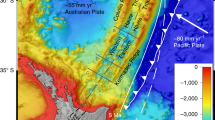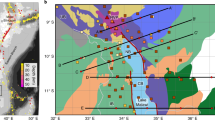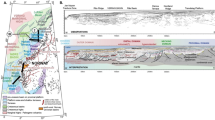Abstract
MUCH of the late Cainozoic history of the western United States is characterized by tensional rifting. The Basin and Range Province is a zone of rifting 300 to 600 km wide (Fig. 1). The Rio Grande depression and the Snake River downwarp are areas of rifting which are similar in time and style to the Basin and Range faulting. The rifting in the Rio Grande depression has usually been related to the same causative mechanism as in the Basin and Range. The Basin and Range type faulting has variously been explained as the result of a westward moving convection cell1; as part of a wide, soft boundary reflecting the transform motion of the American and Pacific plates2; or as the result of a large mantle diapir which came up under the crust following the complete subduction of the Farallon plate in that region3. Although most of these explanations adequately account for the Basin and Range faulting, they fall short in explaining the rifting in the Rio Grande depression. None of the three hypotheses adequately explains why extensive rifting occurs over a area 600 km wide in the Basin and Range abruptly stops for a length of 500 km in the Colorado Plateau area and then resumes again in a narrow zone in the Rio Grande region. The Snake River rifting transects the regional trend of the Basin and Range rifting and does not fit any of the proposed tectonic models for the Basin and Range.
This is a preview of subscription content, access via your institution
Access options
Subscribe to this journal
Receive 51 print issues and online access
$199.00 per year
only $3.90 per issue
Buy this article
- Purchase on Springer Link
- Instant access to full article PDF
Prices may be subject to local taxes which are calculated during checkout
Similar content being viewed by others
References
Cook, K. L., Tectonophysics, 8, 469 (1969).
Atwater, Tanya, Bull. Geol. Soc. Amer., 81, 3513 (1970).
Scholz, C. H., Bull. Geol. Soc. Amer., 82, (1971).
Stone, G. T., thesis, Univ. Colorado (1967).
Lafehr, T. R., and Pakiser, L. C., US Geol. Surv. Prof. Paper, 450 -D, 77 (1962).
Hill, D. P., Baldwin, H. L., and Pakiser, L. C., US Geol. Surv. Prof. Paper, 424 -B, B248 (1961).
Gaca, J. R., and Karig, D. E., US Geol. Surv. Open File Report (1956).
Lipman, P. W., Bull. Geol. Soc. Amer., 80, 1343 (1969).
Deffeyes, K. S., Science Year—The Worldbook Science Annual 1973, 163 (1972).
Morgan, W. J., Nature, 230, 42 (1971).
Coney, P. J., Nature, 233, 462 (1971).
Atwater, Tanya, Bull. Amer. Assoc. Petrol. Geol., 56, 385 (1972).
Author information
Authors and Affiliations
Rights and permissions
About this article
Cite this article
MATTHEWS, V., ANDERSON, C. Yellowstone Convection Plume and Break-up of the Western United States. Nature 243, 158–159 (1973). https://doi.org/10.1038/243158a0
Received:
Issue Date:
DOI: https://doi.org/10.1038/243158a0
This article is cited by
Comments
By submitting a comment you agree to abide by our Terms and Community Guidelines. If you find something abusive or that does not comply with our terms or guidelines please flag it as inappropriate.



